人教版(2019)选择性必修 第四册Unit3 Sea exploration Using language 1课件(共17张,内嵌音频)
文档属性
| 名称 | 人教版(2019)选择性必修 第四册Unit3 Sea exploration Using language 1课件(共17张,内嵌音频) |
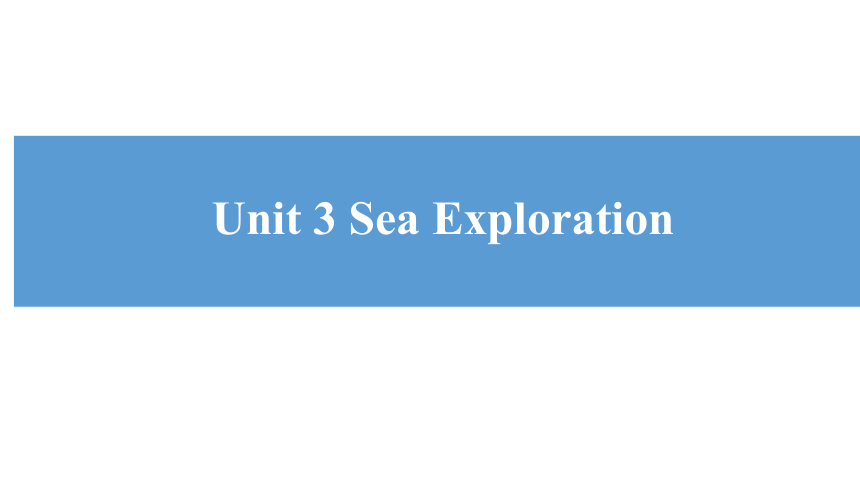
|
|
| 格式 | ppt | ||
| 文件大小 | 2.6MB | ||
| 资源类型 | 教案 | ||
| 版本资源 | 人教版(2019) | ||
| 科目 | 英语 | ||
| 更新时间 | 2024-11-18 11:44:05 | ||
图片预览

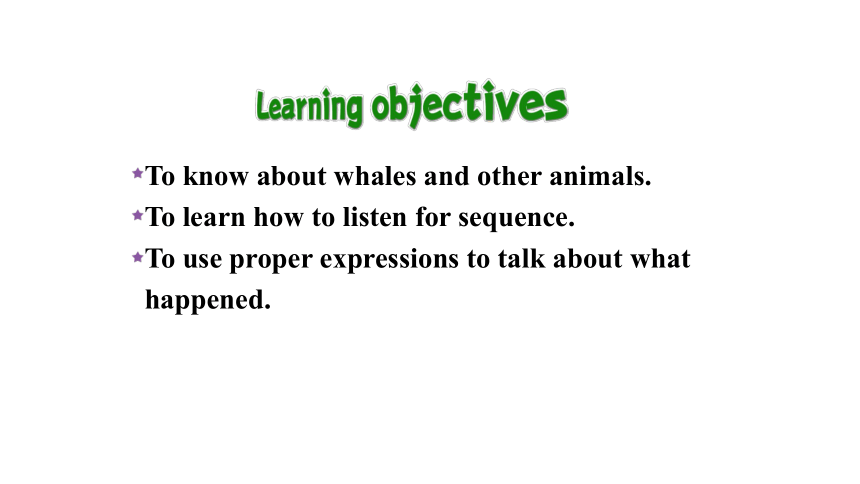
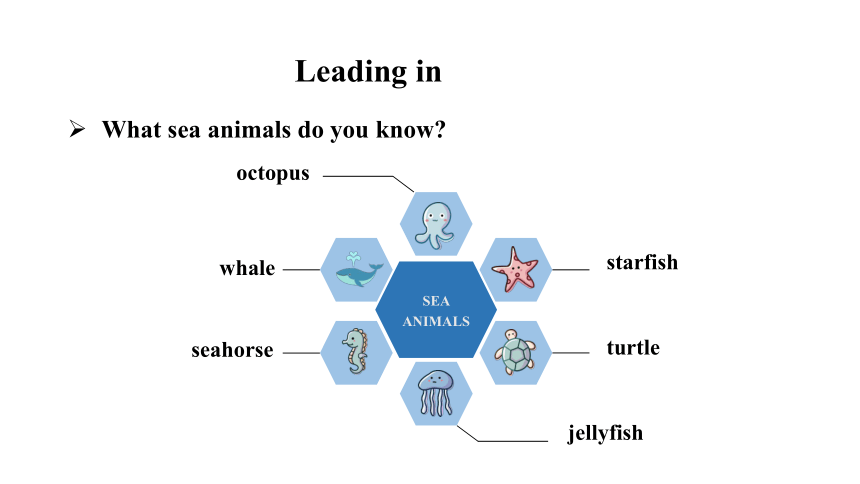
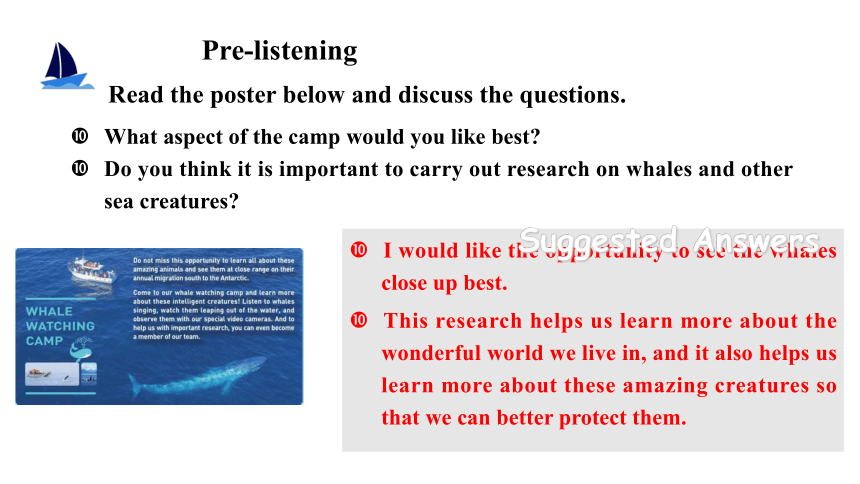

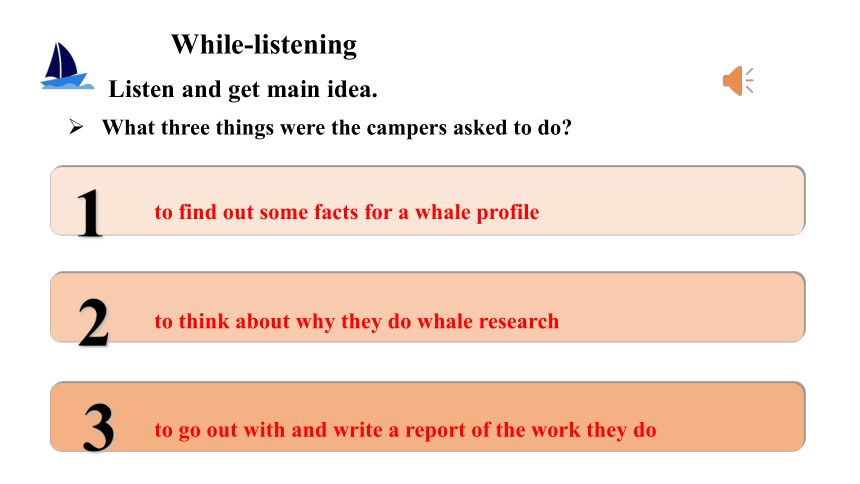
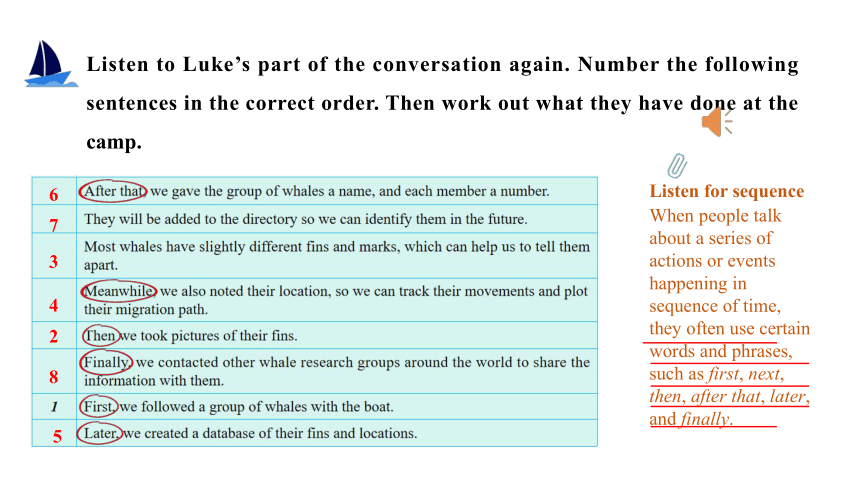
文档简介
(共17张PPT)
Unit 3 Sea Exploration
Using Language (Listening and Speaking)
To know about whales and other animals.
To learn how to listen for sequence.
To use proper expressions to talk about what happened.
Leading in
What sea animals do you know
SEA ANIMALS
octopus
starfish
turtle
jellyfish
seahorse
whale
I would like the opportunity to see the whales close up best.
This research helps us learn more about the wonderful world we live in, and it also helps us learn more about these amazing creatures so that we can better protect them.
Read the poster below and discuss the questions.
Pre-listening
What aspect of the camp would you like best
Do you think it is important to carry out research on whales and other sea creatures
Suggested Answers
Make prediction.
Listen to the head researcher talking to the campers at the end of the day.
Listen and get main idea.
While-listening
What three things were the campers asked to do
1
2
3
to find out some facts for a whale profile
to think about why they do whale research
to go out with and write a report of the work they do
Listen to Luke’s part of the conversation again. Number the following sentences in the correct order. Then work out what they have done at the camp.
Listen for sequence
When people talk about a series of actions or events happening in sequence of time, they often use certain words and phrases, such as first, next, then, after that, later, and finally.
2
3
4
5
6
7
8
Over 80.
The criterion is whether they have teeth or not.
They use sounds to communicate and hunt.
This can help them to tell the whales apart.
They want to share information with them.
Listen to the conversation again and answer the questions.
How many species of whales are there
What is the criterion to divide the main types of whales
What do whales use sounds for
Why do the campers take pictures of the whales’ fins
Why do they contact other research groups
Suggested Answers
Read transcript, and complete the following mindmap about whales.
Post-listening
Whales
(over 80 species)
Whales
with teeth
Whales
without teeth
Food
Species
Food
Typical species
fish, sea animals
70
small organisms
blue whale
Length
Weight
100 feet
200 tons
Some of the students could not make it to the camp. Imagine you were there. Tell your partner about what happened, using the expressions in the box below. Your partner can also ask questions to find out more about what happened.
First(ly), ... Second(ly), ... Third(ly), ... First of all, ...
Then / After that / Afterwards / Next / Later on ...
In the end / At last, ... At that time ...
It began when ... Meanwhile ... Later ... Finally ...
Expressing sequence
EXAMPLE
A: Today we learnt about whales and whale research. First, we found some information and facts about whales. We used the library and the Internet.
B: What did you do after that
...
Speaking
A: Today we learnt about whales and whale research. First, we found some information and facts about whales. We used the library and the Internet.
B: What did you do after that
A: Well, after that we thought about why we do whale research.
B: But why do we do whale research
A: There are lots of reasons. First of all, we need to know how many whales there are. Then, we need to know where they go. And finally, we need to understand more about them.
B: Then what did you do next
A: After that, we went out whale watching, following a group of whales in a boat.
B: That sounds neat. Did you just watch them, or did you do anything else
A: We started by taking pictures of their fins, so we could tell them apart. At the same time, we noted their location, so we could track them.
B: What did you do afterwards
A: We created a database and gave each whale a name and number. Then finally, we shared our information with other whale research groups around the world.
B: It all sounds so wonderful! I wish I could have joined you.
A: I do, too.
Suggested Dialogue
Watch the video Protecting Biodiversity, and then discuss what other sea animals you would like to see. Talk with your partner and make a plan for a trip to see the animals. Your plan should include activities you would like to do.
For our trip, we would like to go to the Shanghai Ocean Aquarium, whose theme is “Spanning five continents by a connection of water”. We can first visit the special exhibition of saving sharks. Then we can go to see the seahorses whose number declined greatly for the past decade. However, most people do not know much about seahorses at all. I think we need to raise awareness about seahorses and marine conservation in China. The last spot will be the Chinese Pavilion, which displays the aquatic organisms and bio-system in the Yangtze River and some national endangered rare aquatic creatures, like Chinese alligator and Chinese Sturgeon.
Listening text
Craig: Here at the camp we are wild about whales! Today you have been helping us with our whale research.First of all, we asked you to find out some facts for a whale profile.What did you find,Sally
Sally: There are over 80 different species of whales. These include the blue whale, the largest known animal to have ever existed. They can grow to 100 feet long,and can weigh nearly 200 tons! There are two main types of whale: those with teeth, and those without.Those without teeth eat very small organisms, whereas those with teeth eat fish and other larger sea animals. More than 70 species of whales have teeth.
Craig: Great!Then,we asked you to think about why we do whale research. Yes, Ben.
Ben: Firstly, it is to monitor how many whales there are. Whales are threatened by many factors, including climate change, pollution, and hunting. Secondly, it is to track where whales go,so we can understand more about them,like their life cycle. Lastly, we know that whales are very intelligent. They communicate and hunt using complex sounds,and even sing and share songs. They can learn by themselves and can teach the things they have learnt to their young.We want to understand more about this.
Craig: Very good,Ben.And lastly,we asked you to go out with us and write a report of the work we do. Can you give us your report, Luke
Luke: Yes. First, we followed a group of whales with the boat.Then we took pictures of their fins.
Most whales have slightly different fins and marks, which can help us to tell them apart.
Meanwhile, we also noted their location, so we can track their movements and plot their
migration path. Later, we created a database of their fins and locations. After that,we gave the
group of whales a name, and each member a number. They will be added to the directory so
we can identify them in the future. Finally, we contacted other whale research groups around
the world to share the information with them.
Craig: Excellent! Thank you all for your help today.
Do you think human beings can still see various sea animals in 100 years and why Do you think protecting biodiversity is an urgent matter and why Write down your thoughts in 100 words.
A young idler, an old beggar.
少壮不努力,老大徒伤悲。
Unit 3 Sea Exploration
Using Language (Listening and Speaking)
To know about whales and other animals.
To learn how to listen for sequence.
To use proper expressions to talk about what happened.
Leading in
What sea animals do you know
SEA ANIMALS
octopus
starfish
turtle
jellyfish
seahorse
whale
I would like the opportunity to see the whales close up best.
This research helps us learn more about the wonderful world we live in, and it also helps us learn more about these amazing creatures so that we can better protect them.
Read the poster below and discuss the questions.
Pre-listening
What aspect of the camp would you like best
Do you think it is important to carry out research on whales and other sea creatures
Suggested Answers
Make prediction.
Listen to the head researcher talking to the campers at the end of the day.
Listen and get main idea.
While-listening
What three things were the campers asked to do
1
2
3
to find out some facts for a whale profile
to think about why they do whale research
to go out with and write a report of the work they do
Listen to Luke’s part of the conversation again. Number the following sentences in the correct order. Then work out what they have done at the camp.
Listen for sequence
When people talk about a series of actions or events happening in sequence of time, they often use certain words and phrases, such as first, next, then, after that, later, and finally.
2
3
4
5
6
7
8
Over 80.
The criterion is whether they have teeth or not.
They use sounds to communicate and hunt.
This can help them to tell the whales apart.
They want to share information with them.
Listen to the conversation again and answer the questions.
How many species of whales are there
What is the criterion to divide the main types of whales
What do whales use sounds for
Why do the campers take pictures of the whales’ fins
Why do they contact other research groups
Suggested Answers
Read transcript, and complete the following mindmap about whales.
Post-listening
Whales
(over 80 species)
Whales
with teeth
Whales
without teeth
Food
Species
Food
Typical species
fish, sea animals
70
small organisms
blue whale
Length
Weight
100 feet
200 tons
Some of the students could not make it to the camp. Imagine you were there. Tell your partner about what happened, using the expressions in the box below. Your partner can also ask questions to find out more about what happened.
First(ly), ... Second(ly), ... Third(ly), ... First of all, ...
Then / After that / Afterwards / Next / Later on ...
In the end / At last, ... At that time ...
It began when ... Meanwhile ... Later ... Finally ...
Expressing sequence
EXAMPLE
A: Today we learnt about whales and whale research. First, we found some information and facts about whales. We used the library and the Internet.
B: What did you do after that
...
Speaking
A: Today we learnt about whales and whale research. First, we found some information and facts about whales. We used the library and the Internet.
B: What did you do after that
A: Well, after that we thought about why we do whale research.
B: But why do we do whale research
A: There are lots of reasons. First of all, we need to know how many whales there are. Then, we need to know where they go. And finally, we need to understand more about them.
B: Then what did you do next
A: After that, we went out whale watching, following a group of whales in a boat.
B: That sounds neat. Did you just watch them, or did you do anything else
A: We started by taking pictures of their fins, so we could tell them apart. At the same time, we noted their location, so we could track them.
B: What did you do afterwards
A: We created a database and gave each whale a name and number. Then finally, we shared our information with other whale research groups around the world.
B: It all sounds so wonderful! I wish I could have joined you.
A: I do, too.
Suggested Dialogue
Watch the video Protecting Biodiversity, and then discuss what other sea animals you would like to see. Talk with your partner and make a plan for a trip to see the animals. Your plan should include activities you would like to do.
For our trip, we would like to go to the Shanghai Ocean Aquarium, whose theme is “Spanning five continents by a connection of water”. We can first visit the special exhibition of saving sharks. Then we can go to see the seahorses whose number declined greatly for the past decade. However, most people do not know much about seahorses at all. I think we need to raise awareness about seahorses and marine conservation in China. The last spot will be the Chinese Pavilion, which displays the aquatic organisms and bio-system in the Yangtze River and some national endangered rare aquatic creatures, like Chinese alligator and Chinese Sturgeon.
Listening text
Craig: Here at the camp we are wild about whales! Today you have been helping us with our whale research.First of all, we asked you to find out some facts for a whale profile.What did you find,Sally
Sally: There are over 80 different species of whales. These include the blue whale, the largest known animal to have ever existed. They can grow to 100 feet long,and can weigh nearly 200 tons! There are two main types of whale: those with teeth, and those without.Those without teeth eat very small organisms, whereas those with teeth eat fish and other larger sea animals. More than 70 species of whales have teeth.
Craig: Great!Then,we asked you to think about why we do whale research. Yes, Ben.
Ben: Firstly, it is to monitor how many whales there are. Whales are threatened by many factors, including climate change, pollution, and hunting. Secondly, it is to track where whales go,so we can understand more about them,like their life cycle. Lastly, we know that whales are very intelligent. They communicate and hunt using complex sounds,and even sing and share songs. They can learn by themselves and can teach the things they have learnt to their young.We want to understand more about this.
Craig: Very good,Ben.And lastly,we asked you to go out with us and write a report of the work we do. Can you give us your report, Luke
Luke: Yes. First, we followed a group of whales with the boat.Then we took pictures of their fins.
Most whales have slightly different fins and marks, which can help us to tell them apart.
Meanwhile, we also noted their location, so we can track their movements and plot their
migration path. Later, we created a database of their fins and locations. After that,we gave the
group of whales a name, and each member a number. They will be added to the directory so
we can identify them in the future. Finally, we contacted other whale research groups around
the world to share the information with them.
Craig: Excellent! Thank you all for your help today.
Do you think human beings can still see various sea animals in 100 years and why Do you think protecting biodiversity is an urgent matter and why Write down your thoughts in 100 words.
A young idler, an old beggar.
少壮不努力,老大徒伤悲。
